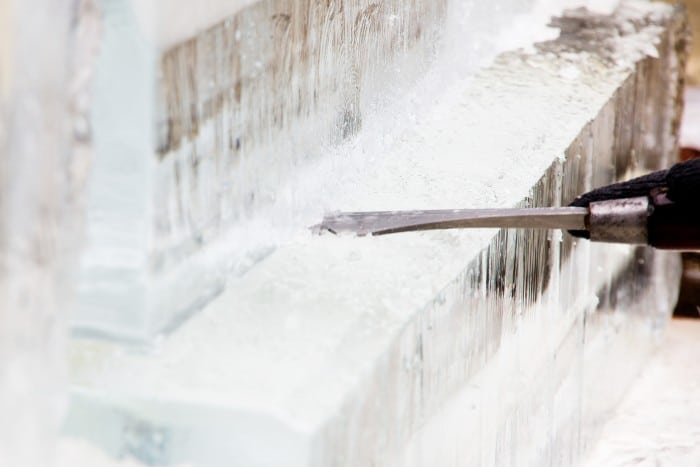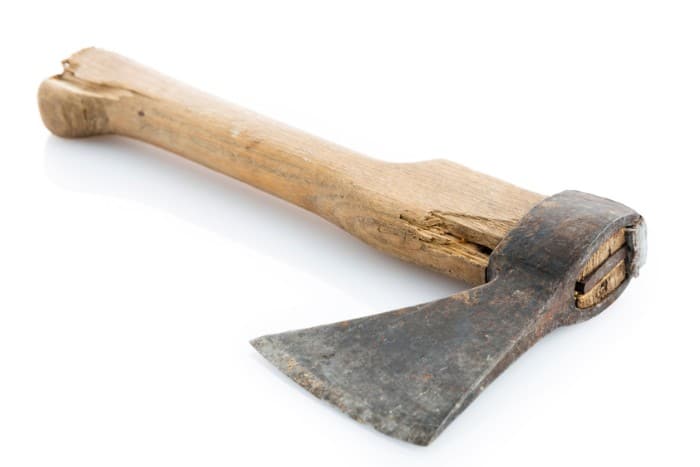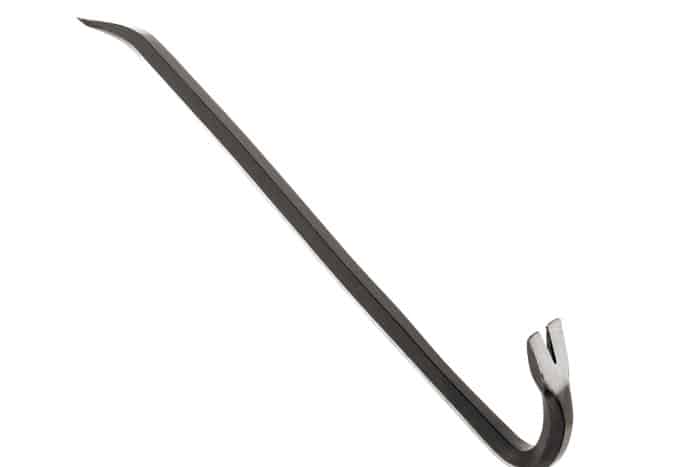Ice fishing augers, especially gas and electric versions, are an expensive and well-adopted option for creating a hole in the ice. However, what can you do to make a hole for ice fishing without an auger?
If an auger is not available to make a hole for ice fishing, you can use many alternative tools to accomplish the same task. Chainsaws, axes, ice chisels, and rocks can be used instead to chip a hole in the ice. An auger is the best tool for the job; people went ice fishing for years before augers.
If you can’t access an auger to make a hole in the ice for ice fishing, any of the tools below can do the trick.
How To Drill Or Make A Hole In The Ice Without An Auger?
Full disclosure: none of the options presented below will be better at drilling a hole in the ice than an auger is.
Many of them require a lot more effort and will not be as smooth as using an auger, but they will work in a pinch.
If you need to drill holes often, or several at a time for use with tip-ups, then investing in an auger can save you hours of making all those holes.
However, these tools can do the trick for the occasional trip out or to try ice fishing before investing in a lot of gear.
Later, you can read our article on ice fishing gear list and see what all do you need to buy.
1. Try Using An Ice Chisel To Make A Hole
Ice chisels are long-handled chisels specifically designed to chip ice away. An ice chisel can make short work of the ice, and you can have a hole in only a few minutes if it isn’t more than a few inches thick.
One of the benefits of an ice chisel is large models allow you to work on the ice while standing, a benefit for your back.
These tools are one of the cheapest available options to make holes in the ice, adding to their popularity.
Ice chisels come in many sizes and material options ranging in price from $20 to $100 for high-end models.
Also called “spud bars,” the ice chisel is an excellent addition to the arsenal even if you have an auger, as a backup is always good to have on hand.

2. A Standard Woodworking Chisel Can Work In A Pinch
While not as effective as an ice chisel, a woodworking chisel can work if you already have one.
In combination with a good hammer, a chisel can be a reasonably good choice to make holes in the ice on a budget.
After chipping a hole in the ice, your chisel will need sharpening to return to its usual condition, but ice should not damage your woodworking chisel.
If you are using a chisel, you’ll also want to bring an ice scoop of some kind to clear the hole of any leftover ice chips.
A chisel has the added benefit of being a lightweight option; if you have to carry your gear a long way, this can be a huge plus if you like to keep things simple.
3. Chainsaws Are The Next Best Thing
Some ice anglers swear by the chainsaw, preferring to use it even over an auger. While loud and heavy, a chainsaw is a very effective way to quickly clear a hole in the ice.
If you already have a chainsaw, you might even prefer to skip getting an auger and use it instead.
One thing to note is that when using a chainsaw, you do not need to use blade oil, as the water from the ice will do a good job keeping the blade lubricated, and you don’t want to get oil in the water.
After using the chainsaw to cut the ice, you’ll still want to care for it to prevent rust and other damage. Also, using a chainsaw is illegal in some areas, so check your local laws before trying it out.
4. Use An Axe To Chip Away A Hole…
An axe was one of the preferred methods to make a hole in the ice for thousands of years before the ice auger came around. Even today, the axe is still a popular tool for ice fishing.
A large axe will result in shorter work to clear the hole, at the cost of more effort to swing and carry the axe. Blade material is also essential to consider, as cheap steel can be prone to chipping, especially in the cold.
You can expect to take anywhere from five to fifteen minutes to chip away the ice, depending on its thickness, so keep that in mind when preparing for your trip.
5. … Or A Hatchet
A hatchet, the little brother of an axe, is another excellent alternative tool to cut a hole in the ice. Although, using one will require you to kneel or crouch on the ice to get close enough to strike it.
The small size of the hatchet makes it a less efficient tool to use than an axe, but for thinner ice, you can still effectively clear a hole for ice fishing.

6. A Splitting Maul Can Accomplish The Same Thing
A splitting maul, for those unaware, is a heavier version of an axe with a thicker wedge for its head. This shape works well for splitting wood, but it also works for ice.
A maul might even be a better option than an axe, thanks to the extra weight putting more power behind each swing, which makes short work of the ice, taking off large chunks with each swing.
If you’re the homesteading type, chances are you already have a splitting maul on hand, so think about taking this on your next ice-fishing trip as an option to break the ice.
7. A Pickaxe Can Work For Ice
Pickaxes might be designed to break up thick soil, but they are also a great tool to break up ice too. The sharp point on a pick can make quick work of ice, putting lots of energy into a concentrated point.
Pickaxes are one of the best tools for chipping away ice, giving chisels a run for their money as a hand tool.
A pickaxe’s large size and extra weight can be a drawback compared to an ice chisel, but if it is what you have on hand, then there is no reason not to try it out.
8. Ice Saws Cut Through Ice Like Butter
Ice hand saws are designed to cut through the ice with minimal effort, which can be ideal for quickly cutting a hole in the ice, large enough for ice fishing.
Folding ice saws are a compact way to carry a tool designed specifically for ice while taking up little space and at a low weight.
Ordinary saws can also be used, but they will not work quite as well due to the smaller teeth.
A benefit of using an ice saw to cut a hole in the ice is choosing the hole size to best suit your needs, for tip-ups, or a larger hole to spear the fish.
9. An Ice Drill Bit Can Almost Compete With An Auger
Ice drill bits are an alternative to an auger and can be paired with any electric drill fitting right into the drill chuck. Not every drill will work for an ice drill bit. A high-torque drill is needed.
An ice drill bit is the closest equivalent to an auger, using a drill rather than hand-powered or gas/electric motors built into the auger.
As a result, an ice drill bit is also more expensive than a hand auger but cheaper than a powered auger sitting in a good spot as an affordable alternative.

10. Cavemen Used Rocks For Everything- You Can Too!
If you are out of luck and have nothing else to make a hole in the ice, a rock can work in a pinch. Tens of thousands of years ago, people used stones for everything, and even today, they can be valuable tools.
Choose a hard rock with a sharp edge, and get to pounding the ice. This method is not very quick or practical, but it is better than not fishing.
This method only works on relatively thin ice, as I would not want to use a rock to make a hole in 9” ice.
Safety is an important consideration with all of these alternative methods, but especially with using a rock that can be prone to chipping and firing dangerous rock chips when you aren’t expecting it.
11. Find A Friend With An Auger
A good option if you are just starting ice fishing is to borrow an auger to drill your hole in the ice if you don’t have one of your own.
Neighbors and other angler friends are a great place to start and ask if they want to go fishing with you or ask to borrow their auger to try it out.
If the body of water you are fishing at has other anglers there, many times, they would be happy to help you out by using their auger to drill a hole or two for you to use.
As long as you’re polite and explain your position to them, many fishermen are friendly and would have no problems helping out.
12. A Digging Iron Is A Good Option
A digging iron is used for breaking up dense clumps of earth to help dig through them and is similar in construction to an ice chisel. It will perform similarly in chipping away the ice as a similar tool.
Digging irons, also known as digging bars, are usually a single piece of metal, creating a very durable tool without any wooden parts to break or other weak points.
13. Crowbars Can Work If Need Be
Not the best tool, but one that can work nonetheless is a crowbar. One benefit of crowbars is that they are one of the most common tools, so you’re likely to already have one you can use.
Crowbars have both a curved end that can be swung and a slightly bent chisel end that can strike straight down into the ice.
A crowbar is by no means the most effective way to make a hole in the ice, but it can work if needed.
You can also use a crowbar in conjunction with an ice saw to pull the block of ice out of the water or push it under the ice away from your hole.

14. Find A Hole To Use
Finding an existing hole in the ice can be a tool-free option to get ice fishing without needing to make the hole yourself. Two options are available: a hole made by another angler or a suckerhole.
A suckerhole is made by an object sticking out of the ice, typically a branch, and the heat from the sun warms up the branch and melts the ice around it.
These are unlikely to be in a good spot to catch fish, but you never know.
You should pay attention to using a hole made by another angler, as you’ll want to be 100% certain that it is not being used by someone else.
However, you could be able to catch someone leaving, and sometimes other anglers might let you use the holes they left behind.
15. Use A Claw Hammer In A Pinch
Even if you aren’t someone with a lot of tools on hand, odds are you probably have a hammer lying around somewhere. If you do, this is good news if you need a way to break the ice.
Using the sharp claw part of the hammer, you can chip away the ice bit by bit to clear out a hole for fishing. It might be a lengthy process with a lightweight hammer, but the end results will be worth it!
Safety Tips
Most of the methods on this list require chipping the ice, which can cause ice chips to fly up and injure your eye.
Wearing eye protection is a must to stay safe out on the ice and prevent any unwanted injuries from occurring.
Many of the tools on this list are also sharp and being swung around, so make sure to be careful and pay attention to what you are doing, as a single missed swing can ruin your fishing trip and end up as a hospital visit.
Warm clothes and plenty of hydration are also critical to a good trip, so be prepared for the length of your time on the ice and the conditions you will encounter out there.
Quick Tips To Keep Your Hole From Freezing Over
If you don’t have an auger, you’ll want to ensure that your ice fishing hole doesn’t freeze over. Here are some quick methods to prevent your hard work from freezing over:
- Skim the ice often
- Use a hole cover
- A water bubbler can keep ice from freezing
- Using an ice fishing tent will help keep the water from freezing
- A hand warmer in a ziplock bag
The End!
Hopefully, this list will help you keep ice fishing without access to an ice auger.
Even a hand auger can make a big difference in the amount of time it takes to drill a hole in the ice, but any other option can work in a pinch.
For thousands of years, people have been ice fishing without augers, so it is possible to go fishing without one.
Axes were the go-to tool for most indigenous anglers and are still a popular option today for some people.
